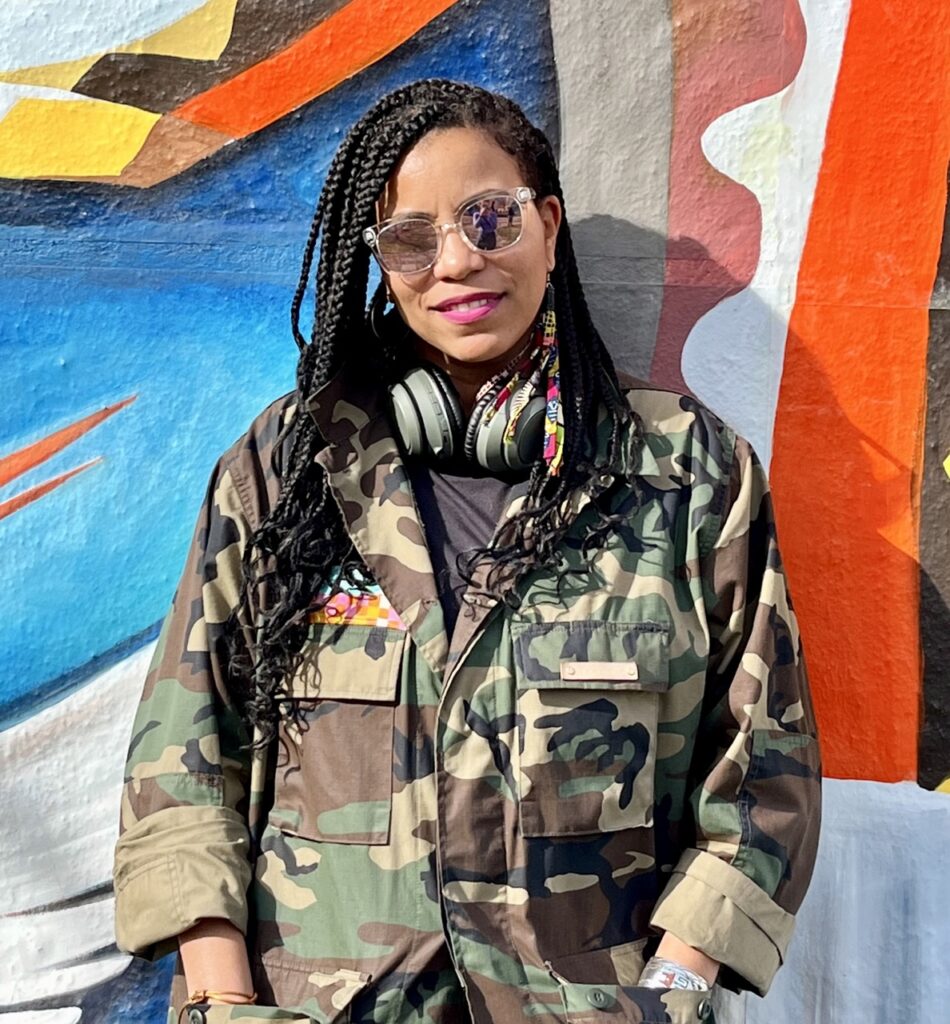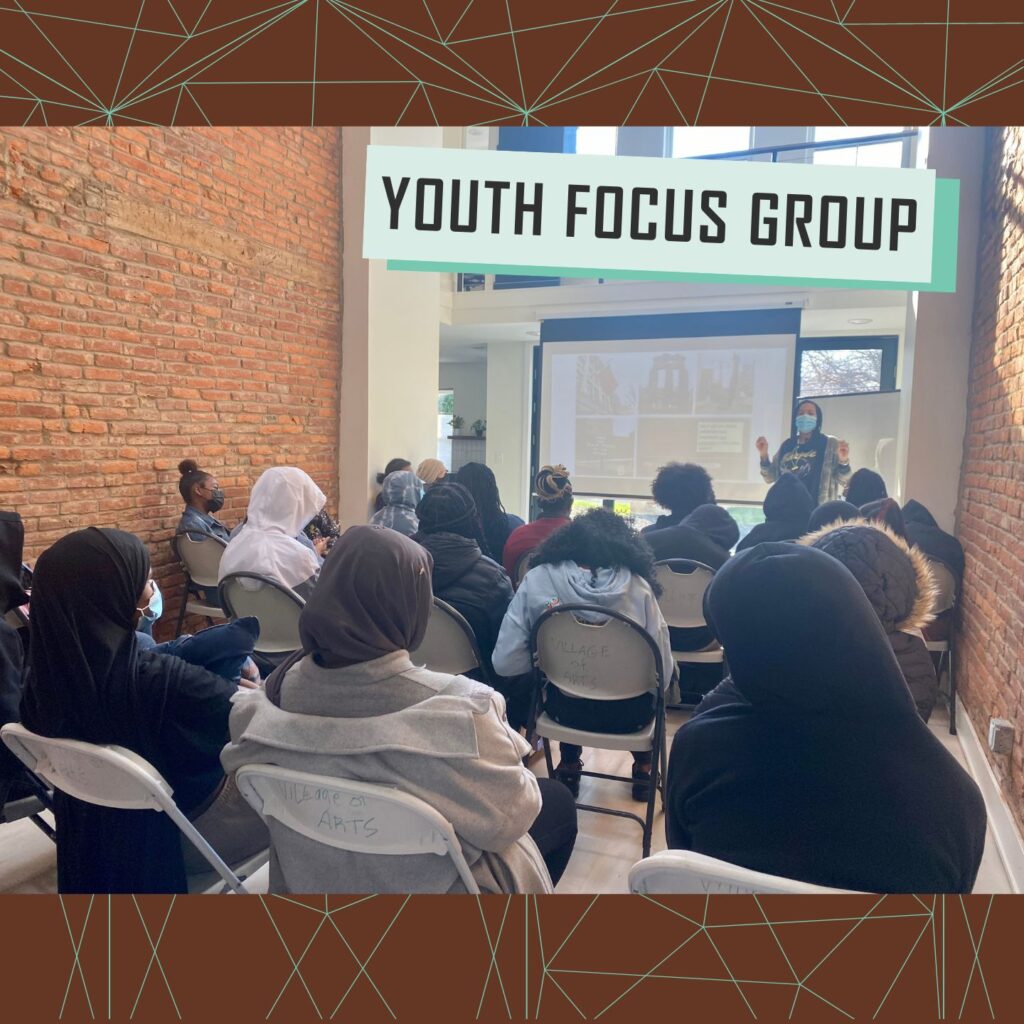
For Li Sumpter, monikers like Afrofuturist, researcher, artist, and professor all apply. But mythologist is the title that she says resonates most deeply. Sumpter achieved a doctorate in Mythological Studies and Depth Psychology in 2014.
“To study myth in such an immersive way was like learning another language. In my early twenties, I wanted to be a linguist like Lieutenant Nyota Uhura of the Starship Enterprise. Myth is the language of the cultural imagination, and Archetype and Symbol are like the nouns and verbs of that language,” Sumpter says.
The story begins when The Village of Arts and Humanities invited Sumpter to create a research project for the upcoming Futures Gallery that represented the ethos of The Village’s home neighborhood, Fairhill-Hartranft — a historically disinvested and redlined section of North Philadelphia. Sumpter’s first step was to learn about the community’s most pressing issues — from past to present, and visions for the future.
“We needed to learn about what they were hoping and dreaming for themselves, their neighborhood, and for their city in years to come,” she says.

To accomplish this, she connected directly with neighborhood elders, youth, The Village staff, and local and national field experts, using interviews and conversations to gather stories and context. After over a year of “researching, planning, and conjuring” along with The Village’s Aviva Kapust and Jeanette Lloyd, Sumpter realized the fully-formed concept for the Village Oracle: a deck of physical cards, accompanying planned art installation, and exhibit.
Sumpter, and her collaborators at The Village, view the resulting art project as the “report to the community” on the extensive research that has been done.
Sumpter reflects, “I leaned into my understanding of mythic literacy and worldbuilding, doing my best to read into the collective story of the Village that was being told through the eyes and experiences of those most connected to its history and future trajectory.” (Sumpter defines worldbuilding as: “the act of creating imaginal realities through everyday stories that tap into the collective myth of a time and place.”)
In thinking about the inspiration for the Village Oracle, Sumpter recounts the creative seeds as: ”The Village community, Village Stories, the research, myth, time, tarot, Philly artists, and Philly soul.”
Collecting and interpreting the stories, told by the voices of the community, led Sumpter to create a series of Archetypes based on the collective character and individual characters of The Village’s home neighborhood.
The resulting Archetypes and Symbols are The Guardian, The Elder, The Youth, The Artist, The Healer, The Scribe, The Capitalist, The Vandal, The Rebel, The Peacemaker, The Afronaut, The Trailblazer, and The Designer.
Tarot, as a personal and creative interest of Sumpter’s, became the natural format for the manifestations of these symbolic Archetypes. During the research phase of The Futures Gallery project, she landed on the tarot deck format.
“After bringing a few of my many decks to introductory meetings and the first round of focus groups with Village members, I realized the pantheons and lexicons known to Tarot would be a perfect visioning tool, an ideal story-based framework to realize the ‘creative research report’ Aviva had in mind,” Sumpter notes.
Tarot has regained popularity in recent years as a creative tool for artistic expression, in the design of the cards themselves, and as a vehicle for storytelling. This year, Sumpter will also produce a deck based on her own original speculative stories and future myths, the Time Binders Tarot Deck. Sumpter sees tarot as a timeless format for the exploration of “personal and collective myths and his/herstories in the making.”
Sumpter’s previous work teaching Afrofuturist art and humanities informed aspects of the Village Oracle. In 2017, she taught an Afrofuturism course at Moore College of Art and Design that combined Afrofuturist ideals with the tarot system of symbolism and iconography as a framework for students’ creative expression. The primary text for the class was Octavia E. Butler’s Parable of the Sower — the eerily-prophetic novel written by Butler in 1993, about a young Black woman living in California in the year 2024, who’s trapped in a dystopian world ravaged by climate disasters, resource insecurity, corrupt government leadership, and extreme wealth disparity. As a final project in Sumpter’s class, students designed a series of cards based on Butler’s text.
“My students always seemed to dive headfirst into this project excited to visually interpret the lead characters, symbols, and themes of O.E.B.’s timely, apocalyptic novel through their own mind’s eye,” she says.
Similarly, the Village Oracle is a collective art endeavor featuring 17 Black Philadelphia artists who were each matched with neighborhood Archetypes and symbols, then tasked with delivering their own creative interpretation. Sumpter herself is an artist on the project, interpreting the Archetype of Afronaut.
She explains, “I wanted to play a creative role. Many of the participating artists are former students or past collaborators, and just folx I’m happy to call friends. After all that work, there was no way I was going to miss out on all the fun that I knew this project was going to be for the artists.”
Sumpter and many of the other artists were particularly excited about the Afronaut archetype. She added the archetype based on what she felt the deck was missing and as a nod to the legendary legacy of Philadelphia’s own Sun Ra, who she names as the original “Afronaut.”
For Sumpter, the culmination of this project, including an outdoor installation and group exhibit in the soon-to-be-built Futures Gallery at The Village, will be symbolic of her evolving community practice. She feels confident that both collective mythmaking and the tarot framework are here to stay as vehicles for communities to express themselves and as tools to understand their own interconnected lives and futures.
She adds, “I’d like to think the Oracle deck we’re making for The Village might move other communities to explore their collective myth and potential futures in the same way. Myth is a language of art and archetype that anyone from The Village community, or the world over, could not only recognize and understand but also use to replicate and reimagine a future of their own design.”
To learn more about The Futures Gallery and Village Oracle, click here.